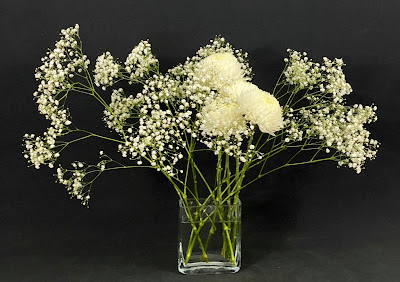Hello all,
I have Green Goddess and arum lilies in great abundance this time of year and I love using them. The arrangement, above, has 12 green goddess lilies and 9 arum lilies. The hand made, glass vases are much prized for their beauty but mostly because they were a gift from my daughter and son-in-law more than a decade ago. I feel there is enough connection between the two arrangements with the matching vases and similar flowers but I wanted to use the wisteria vine to add another element and further connect them. There were tiny leaves on the wisteria when the photograph was taken, which have grown since and are continuing to grow, adding yet another element.
I love the flowers of the cymbidium orchids but I find them very difficult to use in ikebana as their stems are very rigid and will not bend. Their shape, basically, dictates the arrangement. Case in point - the arrangement, below. Having placed the orchids in the metal, wall container, I went looking for complementary material to finish the arrangement. The bamboo oldhamii (Bambusa oldhamii) that is growing in a large pot on our doorstep has some fine, pendulous stems that worked very well in my arrangement, as I had them draping forward, over the orchids. And I was quite happy with the result but not with the photograph. Having lost the depth, it looked messy.
So, out into the garden I went, looking for some other material. I settled on the variegated New Zealand flax, which gets a great deal of use. The arrangement became more dynamic and more to my liking.
We, ikebanists, love the gnarled, twisted or distorted materials, in other words, the imperfect. I came across two such materials, an arum lily and a strelitzia reginae leaf and decided to use them together.
My Japanese maple tree is just outside my studio window and I've enjoyed watching it go from bare branches to slowly filling with fresh growth and leaves. Its branches tend to grow horizontally, making it ideal for a 'Horizontal Arrangement'. I used rhododendron flowers, primmulla and Iris Japonica in a tall, ceramic vase.
I have a small tree of Magnolia Liliiflora nigra, which has been struggling for some years, ever since it had its roots disturbed by some necessary digging. It produced only a handful of flowers this year but I couldn't miss the opportunity to use them.
I've had difficulty growing birds nest fern in the past but the last two years I've had it growing in a pot on the balcony and it's doing very well. So much so, that I could afford to cut a couple of fronds. I used clivias for the mass and crucifix orchids for lines in a ceramic container.
At the beginning of the year I had given my hairdresser some crucifix orchid plants and she gave me some of her miniature orchids (name unknown) in return. I was seriously chuffed when I noticed one of them had brought out 2 flower stems. I, certainly, did not expect flowers so soon. Each flower is only about 10 mm in diameter but they are quite delightful.
 |
I received notification that the Delhi Sogetsu Group have organised a demonstration by Master Instructor Kosa Nishiyama on 6th October at 12.00pm India time and 3.30 pm Japan time. In Melbourne it will be at 4.30 pm.
Ms. Kosa Nishiyama
began studying Sogetsu Ikebana in 1972 and is now a Sogetsu First Grade RIJI Teacher,
a Sogetsu Headquarters Master Instructor, a member of Ikebana International,
and a Fellow of the Nippon Ikebana Art Association. Sensei
Nishiyama has been teaching the Men’s Executive Ikebana Class at Sogetsu
headquarters since 2010.
Ms. Nishiyama hosted the first exhibition of “Seijo Flower Atelier” in 1999. She designed the stage decoration at Oji Hall and held a solo exhibition at the Cera Trading Co., Ltd. Showroom. She created arrangements in the vases of Yutaka Nakamura for his ceramic exhibition at Takashimaya and participated in the Hong Kong Flower Show 2017 as a demonstrator.
Bye for now,
Emily

































